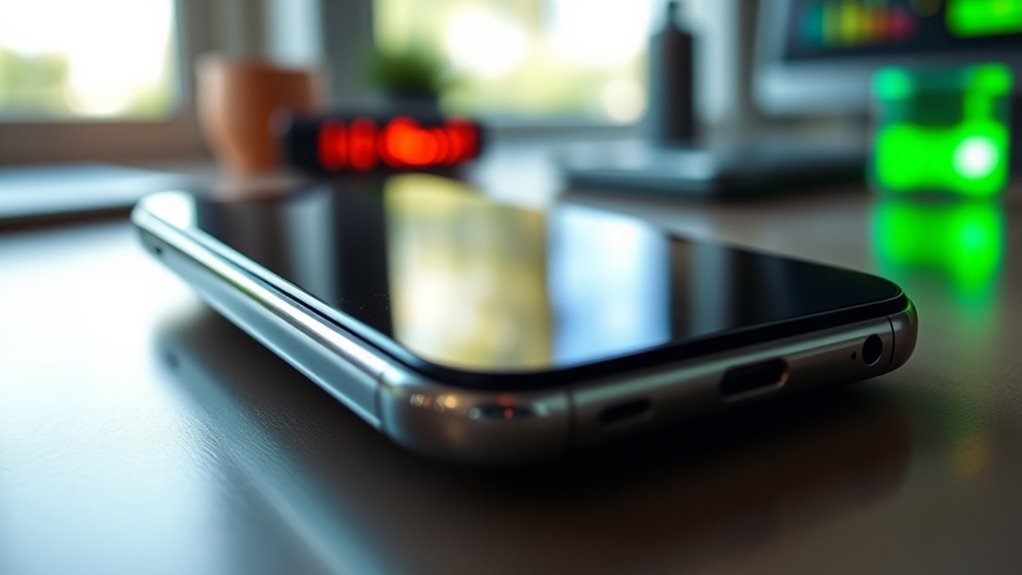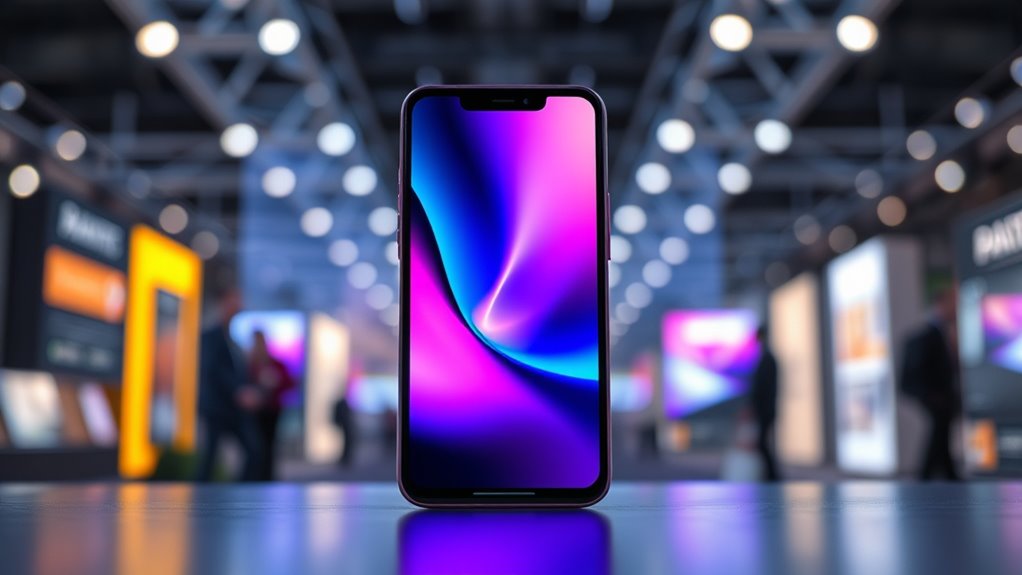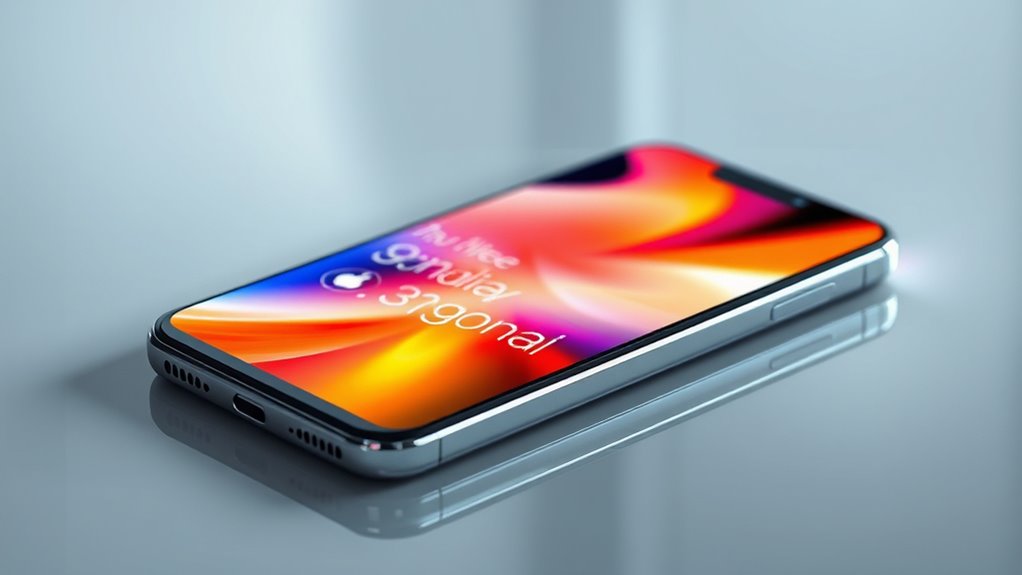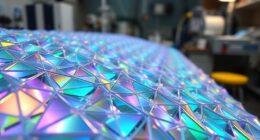MicroLED displays can dramatically extend your phone’s battery life by using energy-efficient, self-emitting tiny LEDs that produce bright, vivid images without needing backlighting. They consume less power compared to traditional screens, which means you could enjoy a week or more on a single charge. As technology advances, improvements in manufacturing and stability are making longer-lasting, high-quality displays a real possibility. Keep exploring to discover how microLEDs are shaping future smartphones and your mobile experience.
Key Takeaways
- MicroLEDs’ high energy efficiency allows smartphones to operate longer on a single charge.
- Their ability to produce brighter images with less power extends battery life significantly.
- MicroLED technology enables thinner, lighter devices, reducing overall power consumption.
- Improved display brightness and color accuracy enhance user experience without draining batteries.
- Advances in scalable manufacturing are making cost-effective, long-lasting MicroLED screens feasible for smartphones.
What Are MicroLEDs and How Do They Work?

MicroLEDs are tiny light-emitting diodes that serve as the building blocks for high-quality displays. They produce light through a process called light emission, where electrical energy excites the material inside each diode, causing it to glow brightly. Quantum dots are often integrated into MicroLED technology to enhance color accuracy and brightness, as they emit pure, vivid colors when energized. When you power a MicroLED display, each micro-sized diode emits its own light independently, creating sharp images with deep blacks and vibrant colors. This precise control over light emission results in better contrast and energy efficiency compared to traditional displays. Because of their small size and efficient light production, MicroLEDs are paving the way for brighter, more durable screens with stunning visual quality. Additionally, advancements in automation technology are expected to improve manufacturing processes for MicroLED displays, making them more affordable and widely available.
Advantages of MicroLED Technology Over Traditional Displays

One of the main advantages of MicroLED technology is its ability to deliver brighter images with better contrast than traditional displays. This results in more vivid visuals, even in bright environments. MicroLEDs are highly energy-efficient because they emit light directly, reducing power consumption and extending battery life. Unlike LCDs, they don’t need backlighting, which further improves efficiency. Additionally, MicroLEDs offer superior color accuracy, providing true-to-life colors with precise control over each pixel. This means your display can show richer, more vibrant images without sacrificing clarity. Moreover, advancements in AI safety measures are driving innovation in display technologies, ensuring that future devices prioritize both performance and security. The combination of high brightness, energy efficiency, and excellent color reproduction makes MicroLEDs a significant upgrade over traditional display technologies, promising devices that are not only stunning to look at but also last longer on a single charge.
Current Challenges in Developing MicroLED Screens

Developing MicroLED screens presents several technical challenges that researchers and manufacturers are actively working to overcome. One major issue is controlling power consumption, especially as screen size increases and more LEDs are integrated. Achieving uniform brightness and color accuracy without draining the battery remains complex. Another challenge is manufacturing scalability; producing millions of tiny LEDs with perfect alignment and high yield is difficult and costly. Ensuring each MicroLED functions reliably over time adds to the complexity. Additionally, transferring microscopic LEDs onto flexible substrates while maintaining precision is a significant hurdle. Advances in LED fabrication techniques are critical for improving production efficiency and reducing costs. These obstacles slow down mass production and raise costs. Overcoming these challenges is essential for making MicroLED displays practical for widespread use in smartphones and other devices, ultimately bringing the promised benefits of longer battery life and superior visuals closer to reality.
Impact on Smartphone Design and User Experience

As manufacturers work to overcome production hurdles, MicroLED technology is poised to transform smartphone design and user experience considerably. You’ll notice improved battery efficiency, allowing your phone to last weeks without frequent charging. This change enables sleeker, more ergonomic designs because manufacturers can reduce the need for bulky batteries. The lighter weight and thinner profiles enhance comfort during prolonged use. To emphasize this shift:
| Feature | Benefit |
|---|---|
| Battery Efficiency | Longer usage between charges |
| Slimmer Design | More comfortable, ergonomic grip |
| Enhanced Display Quality | Better visuals without increasing device size |
This evolution means your phone becomes more portable, easier to hold, and offers a richer visual experience—all while saving battery life. MicroLEDs will redefine how you interact with your device daily, driven by advancements in display technology.
The Future of Mobile Devices With Microleds

MicroLED technology is set to revolutionize mobile devices by enabling thinner, more vibrant, and energy-efficient screens. This advancement opens up exciting possibilities for wearable integration, allowing devices like smartwatches and AR glasses to become sleeker and more visually impressive without sacrificing battery life. As screens become more efficient, you’ll experience longer usage and quicker responses in everyday tasks. Gaming applications will also benefit, with MicroLEDs delivering brighter, more detailed visuals that enhance immersion and reduce lag. Future mobile devices will likely combine MicroLED displays with innovative form factors, making devices more versatile and portable. Additionally, the development of themed events in the tech industry can help introduce consumers to new innovations and foster community engagement. Overall, this technology promises a seamless blend of high performance and extended battery life, transforming how you interact with your mobile devices daily.
Timeline for Commercial MicroLED Smartphone Adoption

Although widespread adoption of MicroLED smartphones is still on the horizon, industry experts predict that commercial availability will begin within the next few years. Advancements in manufacturing scalability are accelerating production, making MicroLED displays more feasible for mass-market phones. As these displays become more scalable, you’ll notice improved battery longevity, since MicroLEDs consume less power and support longer usage times. The timeline depends on overcoming current challenges, such as refining manufacturing processes and reducing costs. Major manufacturers are investing heavily, aiming to launch MicroLED smartphones around 2025 or shortly thereafter. While early models may be limited, the technology’s rapid development promises broader adoption soon, bringing longer-lasting, more vibrant screens to your device. Additionally, improvements in display technology are expected to enhance user experience even further as the technology matures.
Frequently Asked Questions
How Do Microleds Compare to OLEDS in Color Accuracy?
MicroLEDs generally offer better color accuracy than OLEDs because they have superior color reproduction capabilities. They achieve more precise display calibration, resulting in richer, more vibrant colors. Unlike OLEDs, MicroLEDs don’t suffer from burn-in issues, maintaining consistent color quality over time. You’ll notice sharper, more true-to-life images, making them ideal for high-end displays. Overall, MicroLEDs provide an enhanced visual experience through improved color fidelity and stable display calibration.
What Are the Environmental Impacts of Manufacturing Microled Displays?
You might think microled displays are eco-friendly, but the truth is complex. Manufacturing them involves significant energy consumption and recyclability challenges, which can harm the environment. Producing microleds requires specialized materials and processes that consume more resources than traditional screens. While they promise longer-lasting devices, their environmental footprint during manufacturing raises concerns, emphasizing the need for sustainable practices as this technology advances.
Will Microled Technology Increase Smartphone Prices Initially?
Initially, microled technology may cause smartphone prices to rise due to higher manufacturing costs. As manufacturers invest in advanced production processes, market pricing could increase to cover these expenses. However, over time, as the technology matures and economies of scale kick in, prices are likely to stabilize or decrease. You might see a short-term price hike, but long-term affordability should improve as microled production becomes more efficient.
How Durable Are Microled Screens Under Daily Use?
You might wonder how durable microled screens are with daily use. These screens are designed to resist screen scratches better than traditional displays, thanks to their robust materials. They also offer excellent dust resistance, reducing the risk of particles causing damage. While microled technology is promising, it’s still early, so you’ll want to handle your device carefully. Overall, expect good durability, but avoid rough handling to maintain peak performance.
Can Microleds Be Integrated Into Flexible or Foldable Devices?
Imagine a phone that bends effortlessly in your hand, like a smooth riverstone. MicroLEDs can indeed be integrated into flexible and foldable devices, enabling a sleek foldable design that adapts to your needs. Their flexibility allows for durable, vibrant screens that fold seamlessly without damage. So, you’ll enjoy a dynamic, versatile device that combines cutting-edge display tech with the convenience of a foldable, flexible design—perfect for your on-the-go lifestyle.
Conclusion
MicroLEDs are poised to revolutionize your smartphone experience, like a gust of fresh air in a smog-filled city. With longer battery life and stunning visuals, they promise a brighter, more efficient future. Though challenges remain, the horizon looks promising, and it’s only a matter of time before microLEDs become your new standard. Get ready to embrace a world where your device’s power lasts longer than ever—like a marathon runner crossing the finish line.










